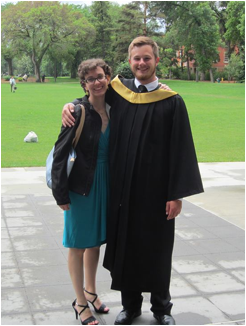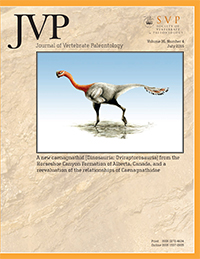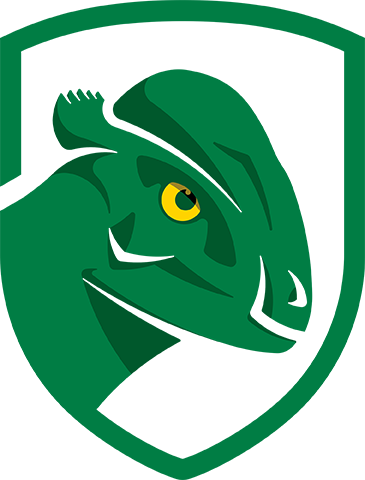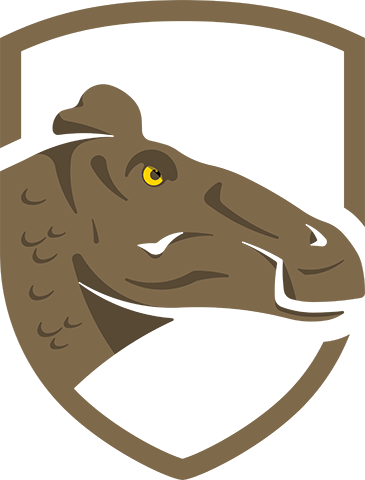’19 PhD, PDF
 Greg completed a PhD and a postdoctoral fellowship as part of the Currie Lab. He studied the anatomy and relationships of oviraptorosaurs, an odd group of pennaraptoran theropods found in Asia and North America. Although they evolved from carnivorous ancestors, they lost their teeth, and developed beaks instead. The group shows remarkable convergence with modern birds—some crested forms resembling modern palaeognaths like cassowaries—and studying their fossil record may shed light on why birds became so successful. Using osteology, comparative anatomy, and functional morphology, his research has demonstrated evidence for an omnivorous diet in caenagathids. Description of several new specimens of oviraptorosaurs has provided anatomical data required to reconstruct their relationships and approach broader evolutionary questions including taxonomy, digit reduction, and body mass to name a few. Greg’s participation in fieldwork has contributed to the discovery and recovery of new oviraptorosaur material, especially in Alberta and Mongolia. He led several seasons of fieldwork in the Red Deer River valley and has also joined Currie Lab crews in Dinosaur Provincial Park, Edmonton, and Argentina.
Greg completed a PhD and a postdoctoral fellowship as part of the Currie Lab. He studied the anatomy and relationships of oviraptorosaurs, an odd group of pennaraptoran theropods found in Asia and North America. Although they evolved from carnivorous ancestors, they lost their teeth, and developed beaks instead. The group shows remarkable convergence with modern birds—some crested forms resembling modern palaeognaths like cassowaries—and studying their fossil record may shed light on why birds became so successful. Using osteology, comparative anatomy, and functional morphology, his research has demonstrated evidence for an omnivorous diet in caenagathids. Description of several new specimens of oviraptorosaurs has provided anatomical data required to reconstruct their relationships and approach broader evolutionary questions including taxonomy, digit reduction, and body mass to name a few. Greg’s participation in fieldwork has contributed to the discovery and recovery of new oviraptorosaur material, especially in Alberta and Mongolia. He led several seasons of fieldwork in the Red Deer River valley and has also joined Currie Lab crews in Dinosaur Provincial Park, Edmonton, and Argentina.
Originally from Yellowknife, NWT, Greg completed a BSc in Paleontology (2013), a PhD with Specialization in Systematics and Evolution (2019), and an appointment as a Postdoctoral Fellow at the University of Alberta. His undergrad thesis involved description, functional morphology, and biomechanics on a caenagnathid jaw used to evaluate diet in this group of toothless dinosaurs. He’s been involved in a number of other projects throughout his studies that include work on brachiopods, troodontid tooth morphology, dinosaur eggshells, and ornithurine bird material. In 2020, Greg joined the Brusatte Lab at University of Edinburgh.
LAB-RELATED PUBLICATIONS
Funston, G.F., Powers, M.J., Whitebone, S.A., Brusatte, S.L., Scannella, J.B., Horner, J.R., and Currie, P.J. 2021. Baby tyrannosaurid bones and teeth from the Late Cretaceous of western North America. Canadian Journal of Earth Sciences (In Press). DOI: 10.1139/cjes-2020-0169
Funston, G.F., Currie, P.J., Tsogtbaatar, C., and Khishigjav, T. 2021. A partial oviraptorosaur skeleton suggests low caenagnathid diversity in the Late Cretaceous Nemegt Formation of Mongolia. PLoS ONE 16(7): e0254564. DOI: 10.1371/journal.pone.0254564
Funston, G.F., Chinzorig, T., Tsogtbaatar, K., Kobayashi, Y., Sullivan, C, and Currie, P.J. 2020. A new two-fingered dinosaur sheds light on the radiation of Oviraptorosauria. Royal Society Open Science 7: 201184. DOI: 10.1098/rsos.201184
Mohr, S.R., Currie, P.J., Acorn, J.H., and Funston, G.F. 2020. An ornithurine bird coracoid from the Late Cretaceous of Alberta, Canada. Canadian Journal of Earth Sciences 58: 134–140. DOI: 10.1139/cjes-2019-0202
Rhodes, M.M., Funston, G.F., and Currie, P.J. 2020. New material reveals the pelvic morphology of Caenagnathidae (Theropoda, Oviraptorosauria). Cretaceous Research 114: 104521. DOI: 10.1016/j.cretres.2020.104521
Funston, G.F. and Currie, P.J. 2020. New material of Chirostenotes pergracilis (Theropoda, Oviraptorosauria) from the Campanian Dinosaur Park Formation of Alberta, Canada. Historical Biology [published online 2020-02-17]. DOI: 10.1080/08912963.2020.1726908
Funston, G.F., Currie, P.J., Ryan, M.J., and Dong, Z.-M. 2019. Birdlike growth and mixed-age flocks in avimimids (Theropoda, Oviraptorosauria). Scientific Reports 9: 18816. DOI: 10.1038/s41598-019-55038-5
Funston, G.F., Wilkinson, R.D., Simon, D.J., LeBlanc, A.H., Wosik, M., and Currie, P.J. 2019. Histology of caenagnathid (Theropoda, Oviraptorosauria) dentaries and implications for development, ontogenetic edentulism, and taxonomy. Anatomical Record 303(4): 918–934. DOI: 10.1002/ar.24205
Funston, G.F. and Currie, P.J. 2018. A small caenagnathid tibia from the Horseshoe Canyon Formation (Maastrichtian): Implications for growth and lifestyle in oviraptorosaurs. Cretaceous Research 92: 220–230. DOI: 10.1016/j.cretres.2018.08.020
Funston, G.F. and Currie, P.J. 2018. The first record of eggshell from the Horseshoe Canyon Formation (Maastrichtian) of Alberta, Canada. Canadian Journal of Earth Sciences 55(4): 436–441. DOI: 10.1139/cjes-2017-0273
Funston, G.F., Mendonca, S.E., Currie, P.J., and Barsbold, R. 2018. A dinosaur community composition dataset for the Late Cretaceous Nemegt Basin of Mongolia. Data in Brief 16: 660–666. DOI: 10.1016/j.dib.2017.11.086
Funston, G.F., Mendonca, S.E., Currie, P.J., and Barsbold, R. 2018. Oviraptorosaur anatomy, diversity and ecology in the Nemegt Basin. Palaeogeography, Palaeoclimatology, Palaeoecology 494: 101–120. DOI: 10.1016/j.palaeo.2017.10.023
Funston, G.F., Martin-Silverstone, E., and Currie, P.J. 2017. The first pterosaur pelvic material from the Dinosaur Park Formation (Campanian) and implications for azhdarchid locomotion. Facets 2: 559–574. DOI: 10.1139/facets-2016-0067
Funston, G.F., Currie, P.J., Eberth, D.A., Ryan, M.J., Chinzorig, T., Badamgarav, D., and Longrich, N.R. 2016. The first oviraptorosaur (Dinosauria: Theropod) bonebed: evidence of gregarious behaviour in a maniraptoran theropod. Scientific Reports 6: 35782. DOI: 10.1038/srep35782
Funston, G.F. and Currie, P.J. 2016. A new caenagnathid (Dinosauria: Oviraptorosauria) from the Horseshoe Canyon Formation of Alberta, Canada, and a reevaluation of the relationships of the Caenagnathidae. Journal of Vertebrate Paleontology 36(3): e1160910. DOI: 10.1080/02724634.2016.1160910

Funston, G.F., Currie, P.J. and Burns, M.E. 2016. New elmisaurine specimens from North America and their relationship to the Mongolian Elmisaurus rarus. Acta Palaeontologica Polonica 61: 159–173. DOI: 10.4202/app.00129.2014
Currie, P.J., Funston, G.F., and Osmólska, H. 2016. New specimens of the crested theropod Elmisaurus rarus from Mongolia. Acta Palaeontologica Polonica 61: 143–157. 10.4202/app.00130.2014
Funston, G.F., Persons, W.S., Bradley, G.J., and Currie, P.J. 2015. New material of the large-bodied caenagnathid Caenagnathus collinsi from the Dinosaur Park Formation of Alberta, Canada. Cretaceous Research 54: 179–187. DOI: 10.1016/j.cretres.2014.12.002
Persons, W.S., Funston, G.F., Currie, P.J., and Norell, M.A. 2015. A possible instance of sexual dimorphism in the tails of two oviraptorosaur dinosaurs. Scientific Reports 5: 9472: DOI: 10.1038/srep09472
Torices, A., Funston, G.F., Kraichy, S.T., and Currie, P.J. 2014. The first appearance of Troodon in the Upper Cretaceous site of Danek Bonebed, and a reevaluation of troodontid quantitative tooth morphotypes. Canadian Journal of Earth Sciences 51: 1039–1044. DOI: 10.1139/cjes-2014-0071
Funston, G.F. and Currie, P.J. 2014. A previously undescribed caenagnathid mandible from the late Campanian of Alberta, and insights into the diet of Chirostenotes pergracilis (Dinosauria: Oviraptorosauria). Canadian Journal of Earth Sciences 51: 156–165. DOI: 10.1139/cjes-2013-0186
Funston, G.F. 2019. Anatomy, systematics, and evolution of Oviraptorosauria (Dinosauria, Theropoda) [doctoral dissertation]. University of Alberta Education and Research Archive. DOI: 10.7939/r3-2w53-m477
OTHER LINKS
Website: https://gregfunston.com/




